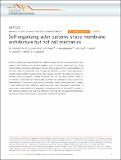| dc.contributor.author | Fritzsche, M. | |
| dc.contributor.author | Li, D. | |
| dc.contributor.author | Colin-York, H. | |
| dc.contributor.author | Chang, V. T. | |
| dc.contributor.author | Felce, J. H. | |
| dc.contributor.author | Sezgin, E. | |
| dc.contributor.author | Charras, G. | |
| dc.contributor.author | Betzig, E. | |
| dc.contributor.author | Eggeling, C. | |
| dc.contributor.author | Moeendarbary, Emadaldin | |
| dc.date.accessioned | 2017-06-21T14:28:55Z | |
| dc.date.available | 2017-06-21T14:28:55Z | |
| dc.date.issued | 2017-02 | |
| dc.date.submitted | 2016-12 | |
| dc.identifier.issn | 2041-1723 | |
| dc.identifier.uri | http://hdl.handle.net/1721.1/110109 | |
| dc.description.abstract | Cell-free studies have demonstrated how collective action of actin-associated proteins can organize actin filaments into dynamic patterns, such as vortices, asters and stars. Using complementary microscopic techniques, we here show evidence of such self-organization of the actin cortex in living HeLa cells. During cell adhesion, an active multistage process naturally leads to pattern transitions from actin vortices over stars into asters. This process is primarily driven by Arp2/3 complex nucleation, but not by myosin motors, which is in contrast to what has been theoretically predicted and observed in vitro. Concomitant measurements of mechanics and plasma membrane fluidity demonstrate that changes in actin patterning alter membrane architecture but occur functionally independent of macroscopic cortex elasticity. Consequently, tuning the activity of the Arp2/3 complex to alter filament assembly may thus be a mechanism allowing cells to adjust their membrane architecture without affecting their macroscopic mechanical properties. | en_US |
| dc.description.sponsorship | Wellcome Trust (WT103883) | en_US |
| dc.language.iso | en_US | |
| dc.publisher | Nature Publishing Group | en_US |
| dc.relation.isversionof | http://dx.doi.org/10.1038/ncomms14347 | en_US |
| dc.rights | Creative Commons Attribution 4.0 International License | en_US |
| dc.rights.uri | http://creativecommons.org/licenses/by/4.0/ | en_US |
| dc.source | Nature | en_US |
| dc.title | Self-organizing actin patterns shape membrane architecture but not cell mechanics | en_US |
| dc.type | Article | en_US |
| dc.identifier.citation | Fritzsche, M.; Li, D.; Colin-York, H.; Chang, V. T.; Moeendarbary, E.; Felce, J. H.; Sezgin, E.; Charras, G.; Betzig, E. and Eggeling, C. “Self-Organizing Actin Patterns Shape Membrane Architecture but Not Cell Mechanics.” Nature Communications 8 (February 2017): 14347 © 2017 The Authors | en_US |
| dc.contributor.department | Massachusetts Institute of Technology. Department of Biological Engineering | en_US |
| dc.contributor.mitauthor | Moeendarbary, Emadaldin | |
| dc.relation.journal | Nature Communications | en_US |
| dc.eprint.version | Final published version | en_US |
| dc.type.uri | http://purl.org/eprint/type/JournalArticle | en_US |
| eprint.status | http://purl.org/eprint/status/PeerReviewed | en_US |
| dspace.orderedauthors | Fritzsche, M.; Li, D.; Colin-York, H.; Chang, V. T.; Moeendarbary, E.; Felce, J. H.; Sezgin, E.; Charras, G.; Betzig, E.; Eggeling, C. | en_US |
| dspace.embargo.terms | N | en_US |
| dc.identifier.orcid | https://orcid.org/0000-0002-7019-3907 | |
| mit.license | PUBLISHER_CC | en_US |
| mit.metadata.status | Complete | |
